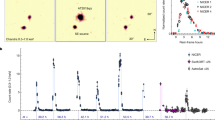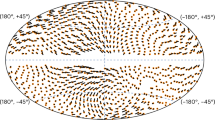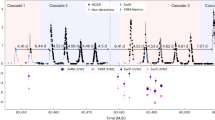Abstract
High-redshift QSOs (quasi-stellar objects) are important because of the information they provide on the early history and evolution of the Universe; the brighter ones are particularly valuable as probes of the intervening material. During the past 20 years much effort has been devoted to trying to discover QSOs at redshifts z > 3.5, but progress has been so slow that it has been suggested that there is a cutoff in the QSO distribution at z ≃ 3.5 (ref. 1). However, we have already demonstrated2–4 how unfiltered UK Schmidt telescope (UKST) IIIa-F low-dispersion objective prism plates can be used successfully in such searches up to at least z ≃ 3.7 (ref. 3). We report here the use of this technique to discover a QSO, 1208 + 1011, with a redshift z = 3.80. The highest redshift previously known was that of the radio-selected QSO, PKS2000–330 with z = 3.78 (ref. 5). In two UKST fields we have now discovered six QSOs with redshifts between 3.3 and 3.8, of which four have z ≥ 3.50; including PKS2000–330, only four other QSOs with z ≥ 3.50 are known over the whole sky5–7,10. Our success up to z = 3.8 indicates that redshifts >4 could soon be attained.
This is a preview of subscription content, access via your institution
Access options
Subscribe to this journal
Receive 51 print issues and online access
$199.00 per year
only $3.90 per issue
Buy this article
- Purchase on SpringerLink
- Instant access to full article PDF
Prices may be subject to local taxes which are calculated during checkout
Similar content being viewed by others
References
Osmer, P. S. Astrophys. J. 253, 28–37 (1982).
Hazard, C. et al. Mon. Not. R. astr. Soc. 211, 45P–50P (1984).
Hazard, C. & McMahon, R. G. Nature 134, 238–240 (1985).
Hazard, C., McMahon, R. G. & Morton, D. C. Mon Mot. R. astr. Soc. (submitted).
Peterson, B., Savage, L. A., Jauncey, D. L. & Wright, A. E. Astrophys. J. 260, L27–L29 (1983).
Wampler, E. J., Robinson, I. B., Baldwin, J. A. & Burbidge, E. M. Nature 243, 336–337 (1973).
Shanks, T., Fong, R. & Boyle, B. J. Nature 303, 156–158 (1983).
Sargent, W.L.W., Filippenko, A. V., Steidel, C., Hazard, C. & McMahon, R. G. Nature 322, 40–42 (1986).
Hazard, C., Morton, D. C., McMahon, R. C., Sargent, W. L. W. & Terlevich, R. Mon. Not. R. astr. Soc. (in the press).
Dunlop, J. S. et al. Nature 319, 564–567 (1986).
Veron-Cetty, M.-P. & Veron, P. A Catalogue of Quasars and Active Nuclei (Eur. Southern Observ. scient. Rep. No. 4, 1985).
Weedman, D. Astrophys. J. Suppl. Ser. 57–532 (1985).
Koo, D. C. in Proc. 24th Liège, int. Astrophys. Colloq. (ed. Swings, J. P.) (University of Liège, 1984).
Schneider, D., Schmidt, M. & Gunn, J. Bull. Am. astr. Soc. 16, 488 (1984).
Author information
Authors and Affiliations
Rights and permissions
About this article
Cite this article
Hazard, C., McMahon, R. & Sargent, W. A QSO with redshift 3.8 found on a UK Schmidt telescope IIIa-F prism plate. Nature 322, 38–40 (1986). https://doi.org/10.1038/322038a0
Received:
Accepted:
Issue date:
DOI: https://doi.org/10.1038/322038a0



